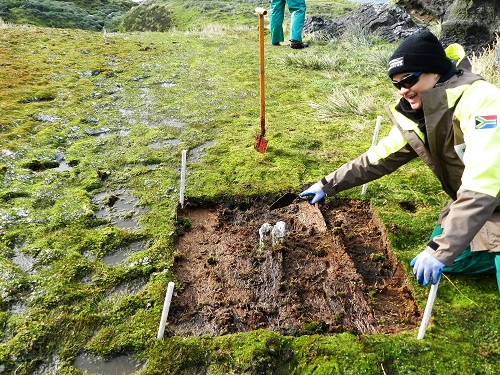Tara van Niekerk examines a test pit exposing wooden planks in the Solglimt survivor’s camp at Ship’s Cove, Marion Island in 2013
The Antarctic Legacy of South Africa is pleased to announce that the fourth higher degree in the humanities has been awarded within the South African National Antarctic Programme.
Marine archaeologist Tara van Niekerk has received a Master of Arts degree from the University of South Africa for her study of the survivor camp erected ashore on Marion Island by the crew of the Norwegian sealer Solglimt, which was deliberately run ashore in a sinking condition in 1908. Her work formed part of the SANAP Archaeologies of Antarctica project of the Iziko Museums of South Africa, managed by Jaco Boshoff of the Museum’s Social History Collections Department. She will graduate in March.


The thesis abstract follows:
“In a tale of survival, dubbed that of the “South Seas Crusoes”, a group of men overcame the odds by setting up camp on a deserted volcanic sub-Antarctic island in the middle of the Southern Indian Ocean. This group of men formed the crew of the Norwegian SS Solglimt sealing vessel which had wrecked on the sub-Antarctic Marion Island in October 1908. More than a century later remains of the shipwreck of the SS Solglimt can still be found lying exposed below the water in the bay of Ships Cove. In the valley north of the bay, the remnants of the shipwreck survivor camp associated with the wreck holds hidden stories of a terrestrial maritime landscape formed out of tragedy and the need to survive. It is mainly the remains of this camp which forms the basis of the research and discussion for this dissertation. The following study is not only an attempt to add to our knowledge and understanding of the archaeological remains on Marion Island, it is also to add to an existing body of knowledge involving shipwreck survivor camps.
The remains on Marion Island have produced the perfect opportunity to fill gaps within the discipline of Maritime Archaeology, especially in South Africa where too often emphasis is placed on shipwreck studies and not enough on the events taking place before or after the crisis event. The following dissertation uses archaeological techniques alongside historical documents as a way to better understand the socio-cultural behaviour of survivors during events of disaster, isolation and the necessity to survive. The study will be used as a comparison to similar studies around the world and hopes to add to an existing body of knowledge involving survivor camps and disaster-response studies from an archaeological and anthropological perspective.”

Tara van Niekerk’s MA follows on from the three higher degrees awarded to Lize-Marié van der Watt (PhD in 2012) and Wouter Hanekom (2013 MA) by Stellenbosch University and Thierry Rousset (2011 MA) from the University of Cape Town, all in the field of historical studies related to South Africa’s Antarctic legacy.
The Antarctic Legacy of South Africa is pleased to have helped with Tara’s research, by supplying translations of unpublished documents, as well as illustrations dealing with the wrecking of the Solglimt. Other close links to Tara’s study is that Jaco Boshoff is a Collaborator with the Antarctic Legacy of South Africa project and ALSA’s Principle Investigator is an Honorary Research Associate of Iziko’s Social History Collections Department.
Read more about ALSA’s archival research on the Solglimt here.
Ship’s Cove, Marion Island, site of the grounding of the Solglimt; photographs by André Botha (left) and the Antarctic Circumnavigation Expedition (right)
ALSA thanks Jaco Boshoff, André Botha, Anders & Erik Evensen, Odd Galteland, Anders, Catherine & Henrik Harboe-Ree, Stig Tore Lunde and Tara van Niekerk for their contributions to unravelling the saga of the Solglimt.
Reference:
Van Niekerk, T.R. 2016. An archaeological study of the Solglimt shipwreck survivor camp on sub-Antarctic Marion Island. Master of Arts in Archaeology, University of South Africa. 133 pp.
John Cooper, Principal Investigator, Antarctic Legacy of South Africa, Department of Botany and Zoology, Stellenbosch University, 16 January 2017
POSTSCRIPT: “Ta–ra–ra Boom-de-ay” is a vaudeville and music hall song from the 1880s.



